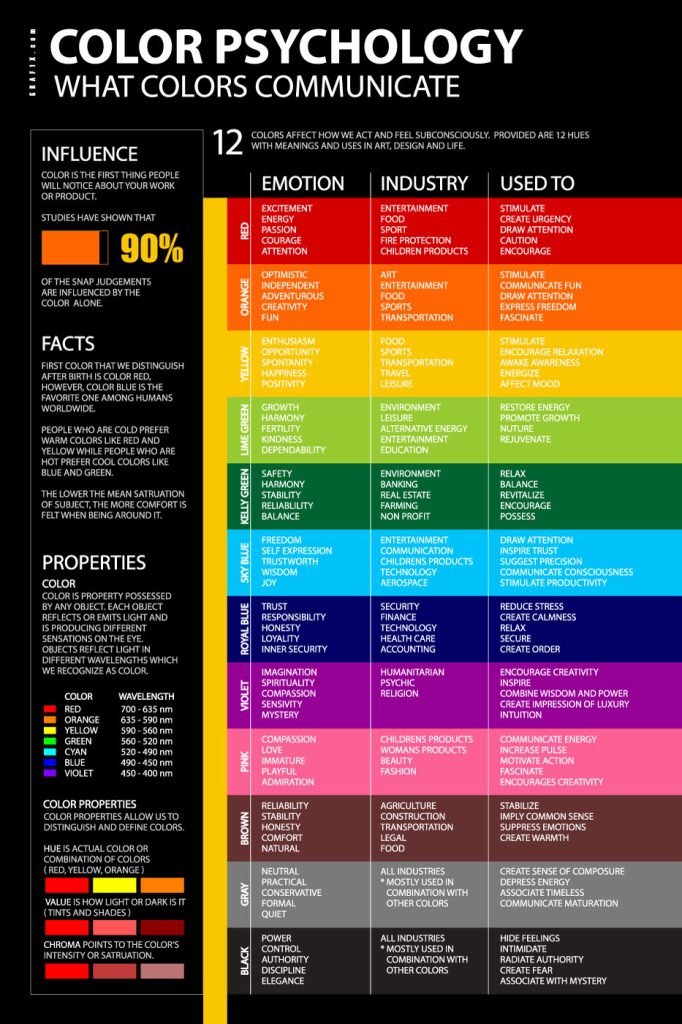Color is more than just a visual element; it’s a powerful tool that can evoke emotions, influence behavior, and even impact our perceptions. Color psychology explores how different colors affect our moods, attitudes, and decision-making processes. Let’s delve into the fascinating world of color psychology and understand how these hues shape our experiences.
The Influence of Color
Color is the first thing people notice about your work or product. Studies have shown that 90% of snap judgments are influenced by color alone. This highlights the crucial role color plays in attracting attention and creating a lasting impression.
Color and Emotion
Colors have a profound impact on our emotions.
- Red: Evokes excitement, energy, passion, and courage. It is often associated with danger, urgency, and stimulation.
- Orange: Communicates enthusiasm, optimism, and independence. It is often used to draw attention and express freedom.
- Yellow: Stimulates creativity, fun, and spontaneity. It is often associated with happiness, opportunity, and optimism.
- Green: Represents growth, harmony, and fertility. It is often associated with nature, peace, and relaxation.
- Blue: Evokes feelings of tranquility, stability, and trustworthiness. It is often associated with calmness, security, and reliability.
- Purple: Suggests wisdom, spirituality, and royalty. It is often associated with luxury, imagination, and creativity.
- Pink: Communicates compassion, sensitivity, and playfulness. It is often associated with femininity, love, and admiration.
- Brown: Represents reliability, stability, and honesty. It is often associated with nature, comfort, and warmth.
- Gray: Conveys neutrality, practicality, and formality. It is often used to create a sense of composure and sophistication.
- Black: Represents power, control, and authority. It is often associated with mystery, elegance, and sophistication.
Color in Different Industries
Colors are strategically used across various industries to evoke specific emotions and influence consumer behavior:
- Food: Red and orange stimulate appetite, while green and blue are often associated with freshness and health.
- Entertainment: Bright colors like red, yellow, and orange are used to create excitement and energy.
- Sports: Red and orange are often used to evoke passion and aggression, while blue and green are associated with calmness and relaxation.
- Retail: Colors like red and yellow are used to draw attention, while blue and green are often used to create a calming and relaxing atmosphere.
- Healthcare: Blue and green are often used in healthcare settings to create a sense of calm and relaxation.
- Finance: Blue and green are often used in finance to convey trust, stability, and reliability.
Color Properties
- Hue: This refers to the actual color or combination of colors (e.g., red, yellow, orange).
- Value: This refers to how light or dark a color is (tints and shades).
- Chroma: This refers to the color’s intensity or saturation.
The Psychology of Color Combinations
Color combinations can create a wide range of emotional responses. For example, combining red and yellow can create a sense of excitement and energy, while combining blue and green can create a calming and relaxing atmosphere.
Conclusion
Color psychology is a fascinating field that explores the profound impact of color on our emotions, behaviors, and perceptions. By understanding how different colors affect us, we can effectively use them to create desired moods, influence decisions, and communicate messages more effectively. Whether you’re a marketer, designer, or simply curious about the psychology of color, this knowledge can be invaluable in enhancing your understanding of the world around you.



